Related Research Articles
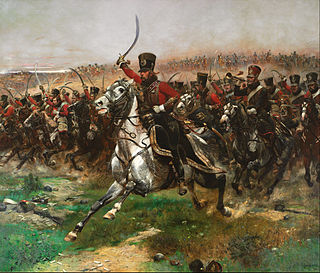
Historically, cavalry are groups of soldiers or warriors who fight mounted on horseback. Until the 20th century, cavalry were the most mobile of the combat arms, operating as light cavalry in the roles of reconnaissance, screening, and skirmishing, or as heavy cavalry for decisive economy of force and shock attacks. An individual soldier in the cavalry is known by a number of designations depending on era and tactics, such as a cavalryman, horseman, trooper, cataphract, knight, drabant, hussar, uhlan, mamluk, cuirassier, lancer, dragoon, samurai or horse archer. The designation of cavalry was not usually given to any military forces that used other animals or platforms for mounts, such as chariots, camels or elephants. Infantry who moved on horseback, but dismounted to fight on foot, were known in the early 17th to the early 18th century as dragoons, a class of mounted infantry which in most armies later evolved into standard cavalry while retaining their historic designation.

Infantry is a specialization of military personnel who engage in warfare combat. Infantry generally consists of light infantry, irregular infantry, heavy infantry, mountain infantry, motorized infantry, mechanized infantry, airborne infantry, air assault infantry, and naval infantry. Other types of infantry, such as line infantry and mounted infantry, were once commonplace but fell out of favor in the 1800s with the invention of more accurate and powerful weapons.
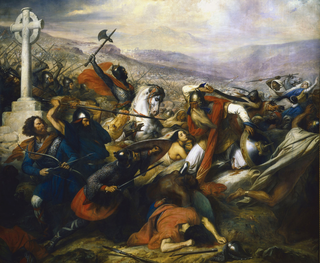
The Battle of Tours, also called the Battle of Poitiers and the Battle of the Highway of the Martyrs, was fought on 10 October 732, and was an important battle during the Umayyad invasion of Gaul. It resulted in victory for the Frankish and Aquitanian forces, led by Charles Martel, over the invading Umayyad forces, led by Abd al-Rahman al-Ghafiqi, governor of al-Andalus. Several historians, such as Edward Gibbon, have credited the Christian victory in the battle as an important factor in curtailing the spread of Islam in Western Europe.
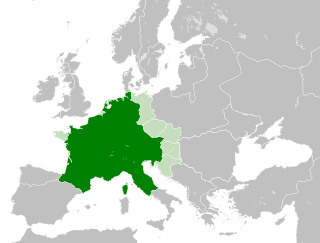
The Carolingian Empire (800–887) was a Frankish-dominated empire in Western and Central Europe during the Early Middle Ages. It was ruled by the Carolingian dynasty, which had ruled as kings of the Franks since 751 and as kings of the Lombards in Italy from 774. In 800, the Frankish king Charlemagne was crowned emperor in Rome by Pope Leo III in an effort to transfer the status of Roman Empire from the Byzantine Empire to Western Europe. The Carolingian Empire is sometimes considered the first phase in the history of the Holy Roman Empire.
A sabre or (American English)saber is a type of backsword with a curved blade associated with the light cavalry of the early modern and Napoleonic periods. Originally associated with Central European cavalry such as the hussars, the sabre became widespread in Western Europe during the Thirty Years' War. Lighter sabres also became popular with infantry of the early 17th century. In the 19th century, models with less curving blades became common and were also used by heavy cavalry.
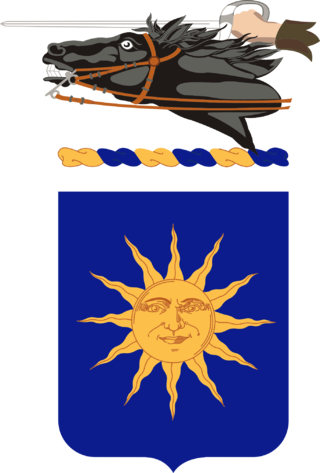
The 26th Cavalry Regiment (Philippine Scouts) (26th CAV (PS)) was part of U.S. Army Forces Far East's Philippine Department, during World War II. The 26th engaged in the last cavalry charge in the history of the U.S. cavalry. The American Battle Monuments Commission list 301 dead who were members of this regiment interred at Manila American Cemetery and Memorial.

The Army of the Republic of Vietnam composed the ground forces of the South Vietnamese military from its inception in 1955 to the Fall of Saigon on 30 April 1975. At the ARVN's peak, an estimated 1 in 9 citizens of South Vietnam were enlisted, composed of Regular Forces and the more voluntary Regional Forces and the Popular Force militias. It is estimated to have suffered 1,394,000 casualties during the Vietnam War.

Buffalo Soldiers were United States Army regiments composed exclusively of African American soldiers, formed during the 19th century to serve on the American frontier. On September 21, 1866, the 10th Cavalry Regiment was formed at Fort Leavenworth, Kansas. The nickname "Buffalo Soldiers" was purportedly given to the regiments by the American Indian tribes who fought against them during the American Indian Wars, and the term eventually became synonymous with all of the African American regiments that were established in 1866, including the 9th Cavalry Regiment, 10th Cavalry Regiment, 24th Infantry Regiment, 25th Infantry Regiment and 38th Infantry Regiment.
The Polish Army is the name applied to the military forces of Poland. The name has been in use since the early 19th century, although it can be used to refer to earlier formations as well. Polish Armed Forces consist of the Army, Navy and Air Force branches and are under the command of the Ministry of National Defense.

The fourragère is a military award, distinguishing military units as a whole, in the form of a braided cord. The award was first adopted by France, followed by other nations such as the Netherlands, Belgium, Portugal, and Luxembourg. Fourragères have been awarded to units of both national and foreign militaries, except for that of Luxembourg, which has not been awarded to any foreign units.

The Byzantine army was the primary military body of the Byzantine armed forces, serving alongside the Byzantine navy. A direct continuation of the Eastern Roman army, shaping and developing itself on the legacy of the late Hellenistic armies, it maintained a similar level of discipline, strategic prowess and organization. It was among the most effective armies of western Eurasia for much of the Middle Ages. Over time the cavalry arm became more prominent in the Byzantine army as the legion system disappeared in the early 7th century. Later reforms reflected some Germanic and Asian influences—rival forces frequently became sources of mercenary units, such as the Huns, Cumans, Alans and Turks, meeting the Empire's demand for light cavalry mercenaries. Since much of the Byzantine military focused on the strategy and skill of generals utilizing militia troops, heavy infantry were recruited from Frankish and later Varangian mercenaries.

The Franks were a group of related Germanic peoples who originally inhabited the regions just beyond Germania Inferior, which was the most northerly province of the Roman Empire in continental Europe. The Frankish tribes lived for centuries under Roman hegemony, near the fortified Rhine river border (Limes). The term "Frank" itself first appears in the third century AD, at a time when Rome had lost full control of the region because of internal conflicts. In the fourth century the Romans also began to distinguish tribes still further north with another new collective term "Saxons", although there are signs that the terms Frank and Saxon were not always mutually exclusive. Over centuries, the Romans recruited large numbers of Frankish soldiers, some of whom achieved high imperial rank.
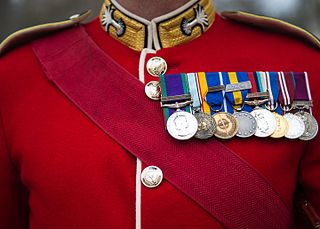
Red coat, also referred to as redcoat or scarlet tunic, is a military garment formerly much used by most regiments of the British Army, so customarily that the term became a common synecdoche for the soldiers themselves.
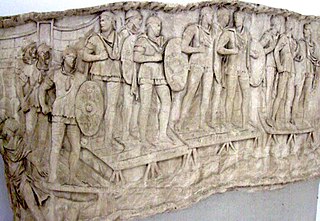
The auxilia were introduced as non-citizen troops attached to the citizen legions by Augustus after his reorganisation of the Imperial Roman army from 27 BC. By the 2nd century, the Auxilia contained the same number of infantry as the legions and, in addition, provided almost all of the Roman army's cavalry and more specialised troops. The auxilia thus represented three-fifths of Rome's regular land forces at that time. Like their legionary counterparts, auxiliary recruits were mostly volunteers, not conscripts.
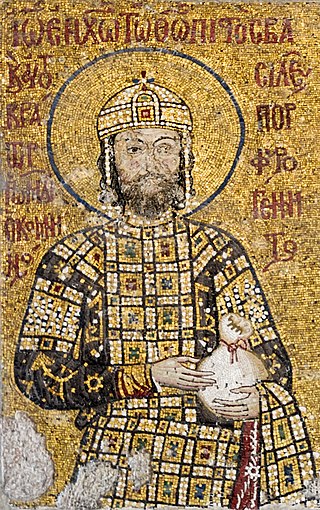
The Byzantine army of the Komnenian era or Komnenian army was a force established by Byzantine emperor Alexios I Komnenos during the late 11th/early 12th century. It was further developed during the 12th century by his successors John II Komnenos and Manuel I Komnenos. From necessity, following extensive territorial loss and a near disastrous defeat by the Normans of southern Italy at Dyrrachion in 1081, Alexios constructed a new army from the ground up. This new army was significantly different from previous forms of the Byzantine army, especially in the methods used for the recruitment and maintenance of soldiers. The army was characterised by an increased reliance on the military capabilities of the immediate imperial household, the relatives of the ruling dynasty and the provincial Byzantine aristocracy. Another distinctive element of the new army was an expansion of the employment of foreign mercenary troops and their organisation into more permanent units. However, continuity in equipment, unit organisation, tactics and strategy from earlier times is evident. The Komnenian army was instrumental in creating the territorial integrity and stability that allowed the Komnenian restoration of the Byzantine Empire. It was deployed in the Balkans, Italy, Hungary, Russia, Anatolia, Syria, the Holy Land and Egypt.
The structural history of the Roman military concerns the major transformations in the organization and constitution of ancient Rome's armed forces, "the most effective and long-lived military institution known to history." At the highest level of structure, the forces were split into the Roman army and the Roman navy, although these two branches were less distinct than in many modern national defense forces. Within the top levels of both army and navy, structural changes occurred as a result of both positive military reform and organic structural evolution. These changes can be divided into four distinct phases.

The Great Stirrup Controversy is the academic debate about the Stirrup Thesis, the theory that feudalism in Europe developed largely as a result of the introduction of the stirrup to cavalry in the 8th century AD. It relates to the hypothesis suggested by Lynn Townsend White Jr. in his 1962 book, Medieval Technology and Social Change. White believed that the stirrup enabled heavy cavalry and shock combat, which in turn prompted the Carolingian dynasty of the 8th and 9th centuries to organize its territory into a vassalage system, rewarding mounted warriors with land grants for their service.

The Eastern Roman army refers to the army of the eastern section of the Roman Empire, from the empire's definitive split in 395 AD to the army's reorganization by themes after the permanent loss of Syria, Palestine and Egypt to the Arabs in the 7th century during the Byzantine-Arab Wars. The East Roman army was the continuation of the Late Roman army of the 4th century, until it gradually transformed into what is now called the Byzantine army from the 7th century onwards.

The Qing dynasty (1644–1912) was established by conquest and maintained by armed force. The founding emperors personally organized and led the armies, and the continued cultural and political legitimacy of the dynasty depended on their ability to defend the country from invasion and expand its territory. Military institutions, leadership, and finance were fundamental to the dynasty's initial success and ultimate decay. The early military system centered on the Eight Banners, a hybrid institution that also played social, economic, and political roles.
The 30th Cavalry Division was a unit of the Soviet Red Army. The unit was disbanded in 1938 but reformed shortly after the June 1941 invasion of the USSR by Nazi Germany. It served on the Southern Front and helped push back Axis forces during the Battle of Rostov. In August 1943 the 30th Cavalry Division was commended by Joseph Stalin for their actions in the liberation of Taganrog and it later operated near Odessa. In the second half of 1944 the division was deployed in the Soviet centre, in modern-day Belarus. The unit received the honorifics "Baranovichi", "Slonim" and "Brest" but was almost destroyed at Nyíregyháza by a German counterattack during the Battle of Debrecen. After the war, the division was briefly converted into the 11th Mechanised Division, disbanded in 1947.
References
- 1 2 3 Bachrach, Bernard S. (2001). Early Carolingian Warfare: Prelude to Empire. Philadelphia, PA: University of Pennsylvania Press. p. 80. ISBN 9780812221442.
- ↑ DeVries, Kelly; Rogers, Clifford J. (2005). The Journal of Medieval Military History. Woodbridge: The Boydell Press. p. 32. ISBN 1843831716.
- ↑ Echevarria, Aitor (2012). The Moon Worshippers. Leicester, UK: Matador. p. 168. ISBN 9781780882178.